Porous Coordination Polymer MOF-808 as an Effective Catalyst to Enhance Sustainable Chemical Processes
Abstract
1. Introduction
2. Materials and Methods
2.1. Reagents and Products
2.2. Characterizations Methods
2.3. Preparation of the Materials
2.4. Catalytic Studies
3. Results and Discussion
3.1. Preparation and Characterization of the Catalysts
3.2. Catalytic Studies
3.3. Catalyst Reutilization and Stability
3.4. Comparison with Reported Works
4. Concluding Remarks
Author Contributions
Funding
Institutional Review Board Statement
Data Availability Statement
Acknowledgments
Conflicts of Interest
References
- Zhou, H.C.; Long, J.R.; Yaghi, O.M. Introduction to Metal-Organic Frameworks. Chem. Rev. 2012, 112, 673–674. [Google Scholar] [CrossRef] [PubMed]
- Bai, Y.; Dou, Y.B.; Xie, L.H.; Rutledge, W.; Li, J.R.; Zhou, H.C. Zr-based metal-organic frameworks: Design, synthesis, structure, and applications. Chem. Soc. Rev. 2016, 45, 2327–2367. [Google Scholar] [CrossRef] [PubMed]
- Lin, Z.J.; Zheng, H.Q.; Chen, J.; Zhuang, W.E.; Lin, Y.X.; Su, J.W.; Huang, Y.B.; Cao, R. Encapsulation of Phosphotungstic Acid into Metal-Organic Frameworks with Tunable Window Sizes: Screening of PTA@MOF Catalysts for Efficient Oxidative Desulfurization. Inorg. Chem. 2018, 57, 13009–13019. [Google Scholar] [CrossRef] [PubMed]
- Păun, C.; Motelică, L.; Ficai, D.; Ficai, A.; Andronescu, E. Metal-organic frameworks: Versatile platforms for biomedical innovations. Materials 2023, 16, 6143. [Google Scholar] [CrossRef] [PubMed]
- Mousavi, S.M.; Hashemi, S.A.; Fallahi Nezhad, F.; Binazadeh, M.; Dehdashtijahromi, M.; Omidifar, N.; Ghahramani, Y.; Lai, C.W.; Chiang, W.-H.; Gholami, A. Innovative metal-organic frameworks for targeted oral cancer therapy: A review. Materials 2023, 16, 4685. [Google Scholar] [CrossRef] [PubMed]
- Xie, Y.; Lyu, S.; Zhang, Y.; Cai, C. Adsorption and Degradation of Volatile Organic Compounds by Metal–Organic Frameworks (MOFs): A Review. Materials 2022, 15, 7727. [Google Scholar] [CrossRef] [PubMed]
- Saeb, M.R.; Rabiee, N.; Mozafari, M.; Mostafavi, E. Metal-Organic Frameworks (MOFs)-based nanomaterials for drug delivery. Materials 2021, 14, 3652. [Google Scholar] [CrossRef] [PubMed]
- Jiao, L.; Wang, Y.; Jiang, H.-L.; Xu, Q. Metal–Organic Frameworks as Platforms for Catalytic Applications. Adv. Mater. 2018, 30, 1703663. [Google Scholar] [CrossRef] [PubMed]
- Chughtai, A.H.; Ahmad, N.; Younus, H.A.; Laypkov, A.; Verpoort, F. Metal-organic frameworks: Versatile heterogeneous catalysts for efficient catalytic organic transformations. Chem. Soc. Rev. 2015, 44, 6804–6849. [Google Scholar] [CrossRef] [PubMed]
- Liu, J.W.; Chen, L.F.; Cui, H.; Zhang, J.Y.; Zhang, L.; Su, C.Y. Applications of metal-organic frameworks in heterogeneous supramolecular catalysis. Chem. Soc. Rev. 2014, 43, 6011–6061. [Google Scholar] [CrossRef] [PubMed]
- Dhakshinamoorthy, A.; Opanasenko, M.; Cejka, J.; Garcia, H. Metal organic frameworks as heterogeneous catalysts for the production of fine chemicals. Catal. Sci. Technol. 2013, 3, 2509–2540. [Google Scholar] [CrossRef]
- Yoon, M.; Srirambalaji, R.; Kim, K. Homochiral Metal-Organic Frameworks for Asymmetric Heterogeneous Catalysis. Chem. Rev. 2012, 112, 1196–1231. [Google Scholar] [CrossRef] [PubMed]
- Corma, A.; Garcia, H.; Xamena, F. Engineering metal-organic frameworks for heterogeneous catalysis. Chem. Rev. 2010, 110, 4606–4655. [Google Scholar] [CrossRef] [PubMed]
- Liu, Y.; Xuan, W.M.; Cui, Y. Engineering Homochiral Metal-Organic Frameworks for Heterogeneous Asymmetric Catalysis and Enantioselective Separation. Adv. Mater. 2010, 22, 4112–4135. [Google Scholar] [CrossRef] [PubMed]
- Tang, F.S.; Zhao, J.C.G.; Chen, B.L. Porous Coordination Polymers for Heterogeneous Catalysis. Curr. Org. Chem. 2018, 22, 1773–1791. [Google Scholar] [CrossRef]
- Fan, F.Q.; Zhao, L.; Zeng, Q.Q.; Zhang, L.Y.; Zhang, X.M.; Wang, T.Q.; Fu, Y. Self-Catalysis Transformation of Metal-Organic Coordination Polymers. ACS Appl. Mater. Interfaces 2023, 15, 37086–37092. [Google Scholar] [CrossRef]
- Gogoi, C.; Nagarjun, N.; Roy, S.; Mostakim, S.K.; Volkmer, D.; Dhakshinamoorthy, A.; Biswas, S. A Zr-based metal-organic framework with a DUT-52 structure containing a trifluoroacetamido-functionalized linker for aqueous phase fluorescence sensing of the cyanide ion and aerobic oxidation of cyclohexane. Inorg. Chem. 2021, 60, 4539–4550. [Google Scholar] [CrossRef] [PubMed]
- Wang, Y.; Li, L.; Yan, L.; Cao, L.; Dai, P.; Gu, X.; Zhao, X. Continuous synthesis for zirconium metal-organic frameworks with high quality and productivity via microdroplet flow reaction. Chin. Chem. Lett. 2018, 29, 849–853. [Google Scholar] [CrossRef]
- Gu, Y.; Ye, G.; Xu, W.; Zhou, W.; Sun, Y. Creation of Active Sites in MOF-808(Zr) by a Facile Route for Oxidative Desulfurization of Model Diesel Oil. ChemistrySelect 2020, 5, 244–251. [Google Scholar] [CrossRef]
- Ruediger, E.; Martel, A.; Meanwell, N.; Solomon, C.; Turmel, B. Novel 3′-deoxy analogs of the anti-HBV agent entecavir: Synthesis of enantiomers from a single chiral epoxide. Tetrahedron Lett. 2004, 45, 739–742. [Google Scholar] [CrossRef]
- Aramesh, N.; Yadollahi, B.; Mirkhani, V. Fe(III) substituted Wells–Dawson type polyoxometalate: An efficient catalyst for ring opening of epoxides with aromatic amines. Inorg. Chem. Commun. 2013, 28, 37–40. [Google Scholar] [CrossRef]
- Liu, J.W.; Tang, W.; Wang, C. Nickel-Catalyzed Regio- and Enantioselective Ring Opening of 3,4-Epoxy Amides and Esters with Aromatic Amines. Chem. A Eur. J. 2023, 29, e202300704. [Google Scholar] [CrossRef] [PubMed]
- Deshpande, N.; Parulkar, A.; Joshi, R.; Diep, B.; Kulkarni, A.; Brunelli, N.A. Epoxide ring opening with alcohols using heterogeneous Lewis acid catalysts: Regioselectivity and mechanism. J. Catal. 2019, 370, 46–54. [Google Scholar] [CrossRef]
- Bonini, C.; Righi, G. Regio- and chemoselective synthesis of halohydrins by cleavage of oxiranes with metal halides. Synthesis 1994, 1994, 225–238. [Google Scholar] [CrossRef]
- Mancilla, G.; Femenía-Ríos, M.; Macías-Sánchez, A.J.; Collado, I.G. Sn(OTf)2 catalysed regioselective styrene oxide ring opening with aromatic amines. Tetrahedron 2008, 64, 11732–11737. [Google Scholar] [CrossRef]
- Danafar, H.; Yadollahi, B. (TBA)4PFeW11O39·3H2O catalyzed efficient and facile ring opening reaction of epoxides with aromatic amines. Cat. Commun. 2009, 10, 842–847. [Google Scholar] [CrossRef]
- Mohseni, S.; Bakavoli, M.; Morsali, A. Theoretical and Experimental Studies on the Regioselectivity of Epoxide Ring Opening by Nucleophiles in Nitromethane without any Catalyst: Nucleophilic-Chain Attack Mechanism. Prog. React. Kinet. Mech. 2014, 39, 89–102. [Google Scholar] [CrossRef]
- Barbosa, A.D.S.; Julião, D.; Fernandes, D.M.; Peixoto, A.F.; Freire, C.; de Castro, B.; Granadeiro, C.M.; Balula, S.S.; Cunha-Silva, L. Catalytic performance and electrochemical behaviour of metal–organic frameworks: MIL-101(Fe) versus NH2-MIL-101(Fe). Polyhedron 2017, 127, 464–470. [Google Scholar] [CrossRef]
- Xu, S.; Gao, Q.; Zhou, C.; Li, J.; Shen, L.; Lin, H. Improved thermal stability and heat-aging resistance of silicone rubber via incorporation of UiO-66-NH2. Mater. Chem. Phys. 2021, 274, 125182. [Google Scholar] [CrossRef]
- Mirante, F.; Leo, P.; Dias, C.N.; Cunha-Silva, L.; Balula, S.S. MOF-808 as an Efficient Catalyst for Valorization of Biodiesel Waste Production: Glycerol Acetalization. Materials 2023, 16, 7023. [Google Scholar] [CrossRef] [PubMed]
- Silva, D.F.; Faria, R.G.; Santos-Vieira, I.; Cunha-Silva, L.; Granadeiro, C.M.; Balula, S.S. Simultaneous sulfur and nitrogen removal from fuel combining activated porous MIL-100(Fe) catalyst and sustainable solvents. Cat. Today 2023, 423, 114250. [Google Scholar] [CrossRef]
- Gao, Y.; Granadeiro, C.M.; Cunha-Silva, L.; Zhao, J.; Balula, S.S. Peroxomolybdate@MOFs as effective catalysts for oxidative desulfurization of fuels: Correlation between MOF structure and catalytic activity. Catal. Sci. Technol. 2023, 13, 4785–4801. [Google Scholar] [CrossRef]
- Lara-Serrano, M.; Morales-delaRosa, S.; Campos-Martin, J.M.; Abdelkader-Fernández, V.K.; Cunha-Silva, L.; Balula, S.S. One-Pot Conversion of Glucose into 5-Hydroxymethylfurfural using MOFs and Brønsted-Acid Tandem Catalysts. Adv. Sustain. Syst. 2022, 6, 2100444. [Google Scholar] [CrossRef]
- Lara-Serrano, M.; Morales-DelaRosa, S.; Campos-Martin, J.M.; Abdelkader-Fernández, V.K.; Cunha-Silva, L.; Balula, S.S. Isomerization of glucose to fructose catalyzed by metal-organic frameworks. Sustain. Energy Fuels 2021, 5, 3847–3857. [Google Scholar] [CrossRef]
- Viana, A.M.; Julião, D.; Mirante, F.; Faria, R.G.; de Castro, B.; Balula, S.S.; Cunha-Silva, L. Straightforward activation of metal-organic framework UiO-66 for oxidative desulfurization processes. Cat. Today 2021, 362, 28–34. [Google Scholar] [CrossRef]
- Julião, D.; Barbosa, A.D.S.; Peixoto, A.F.; Freire, C.; De Castro, B.; Balula, S.S.; Cunha-Silva, L. Improved catalytic performance of porous metal-organic frameworks for the ring opening of styrene oxide. CrystEngComm 2017, 19, 4219–4226. [Google Scholar] [CrossRef]
- Furukawa, H.; Gándara, F.; Zhang, Y.-B.; Jiang, J.; Queen, W.L.; Hudson, M.R.; Yaghi, O.M. Water Adsorption in Porous Metal–Organic Frameworks and Related Materials. J. Am. Chem. Soc. 2014, 136, 4369–4381. [Google Scholar] [CrossRef] [PubMed]
- Ma, Y.; Han, X.; Xu, S.; Wang, Z.; Li, W.; da Silva, I.; Chansai, S.; Lee, D.; Zou, Y.; Nikiel, M.; et al. Atomically Dispersed Copper Sites in a Metal–Organic Framework for Reduction of Nitrogen Dioxide. J. Am. Chem. Soc. 2021, 143, 10977–10985. [Google Scholar] [CrossRef] [PubMed]
- Dai, S.; Simms, C.; Dovgaliuk, I.; Patriarche, G.; Tissot, A.; Parac-Vogt, T.N.; Serre, C. Monodispersed MOF-808 nanocrystals synthesized via a scalable room-temperature approach for efficient heterogeneous peptide bond hydrolysis. Chem. Mater. 2021, 33, 7057–7066. [Google Scholar] [CrossRef]
- Luu, C.L.; Van Nguyen, T.T.; Nguyen, T.; Hoang, T.C. Synthesis, characterization and adsorption ability of UiO-66-NH2. Adv. Nat. Sci. Nanosci. Nanotechnol. 2015, 6, 025004. [Google Scholar] [CrossRef]
- Dreischarf, A.C.; Lammert, M.; Stock, N.; Reinsch, H. Green Synthesis of Zr-CAU-28: Structure and Properties of the First Zr-MOF Based on 2,5-Furandicarboxylic Acid. Inorg. Chem. 2017, 56, 2270–2277. [Google Scholar] [CrossRef] [PubMed]
- Romero-Muñiz, I.; Romero-Muñiz, C.; del Castillo-Velilla, I.; Marini, C.; Calero, S.; Zamora, F.; Platero-Prats, A.E. Revisiting Vibrational Spectroscopy to Tackle the Chemistry of Zr6O8 Metal-Organic Framework Nodes. ACS Appl. Mater. Interfaces 2022, 14, 27040–27047. [Google Scholar] [CrossRef] [PubMed]
- Timofeev, K.L.; Kulinich, S.A.; Kharlamova, T.S. NH2-Modified UiO-66: Structural Characteristics and Functional Properties. Molecules 2023, 28, 3916. [Google Scholar] [CrossRef] [PubMed]
- Nguyen, K.D.; Vo, N.T.; Le, K.T.M.; Ho, K.V.; Phan, N.T.S.; Ho, P.H.; Le, H.V. Defect-engineered metal–organic frameworks (MOF-808) towards the improved adsorptive removal of organic dyes and chromium (vi) species from water. New J. Chem. 2023, 47, 6433–6447. [Google Scholar] [CrossRef]
- Ye, G.; Wan, L.; Zhang, Q.; Liu, H.; Zhou, J.; Wu, L.; Zeng, X.; Wang, H.; Chen, X.; Wang, J. Boosting Catalytic Performance of MOF-808(Zr) by Direct Generation of Rich Defective Zr Nodes via a Solvent-Free Approach. Inorg. Chem. 2023, 62, 4248–4259. [Google Scholar] [CrossRef] [PubMed]
- Farrando-Pérez, J.; Martinez-Navarrete, G.; Gandara-Loe, J.; Reljic, S.; Garcia-Ripoll, A.; Fernandez, E.; Silvestre-Albero, J. Controlling the Adsorption and Release of Ocular Drugs in Metal–Organic Frameworks: Effect of Polar Functional Groups. Inorg. Chem. 2022, 61, 18861–18872. [Google Scholar] [CrossRef] [PubMed]
- Jiang, D.; Mallat, T.; Krumeich, F.; Baiker, A. Copper-based metal-organic framework for the facile ring-opening of epoxides. J. Catal. 2008, 257, 390–395. [Google Scholar] [CrossRef]
- Dhakshinamoorthy, A.; Alvaro, M.; Garcia, H. Metal–organic frameworks as efficient heterogeneous catalysts for the regioselective ring opening of epoxides. Chem. Eur. J. 2010, 16, 8530–8536. [Google Scholar] [CrossRef]
- Anbu, N.; Dhakshinamoorthy, A. Regioselective ring opening of styrene oxide by carbon nucleophiles catalyzed by metal–organic frameworks under solvent-free conditions. J. Ind. Eng. Chem. 2018, 58, 9–17. [Google Scholar] [CrossRef]
- Kumar, G.; Singh, A.P.; Gupta, R. Synthesis, structures, and heterogeneous catalytic applications of {Co3+–Eu3+} and {Co3+–Tb3+} heterodimetallic coordination polymers. Eur. J. Inorg. Chem. 2010, 2010, 5103–5112. [Google Scholar] [CrossRef]

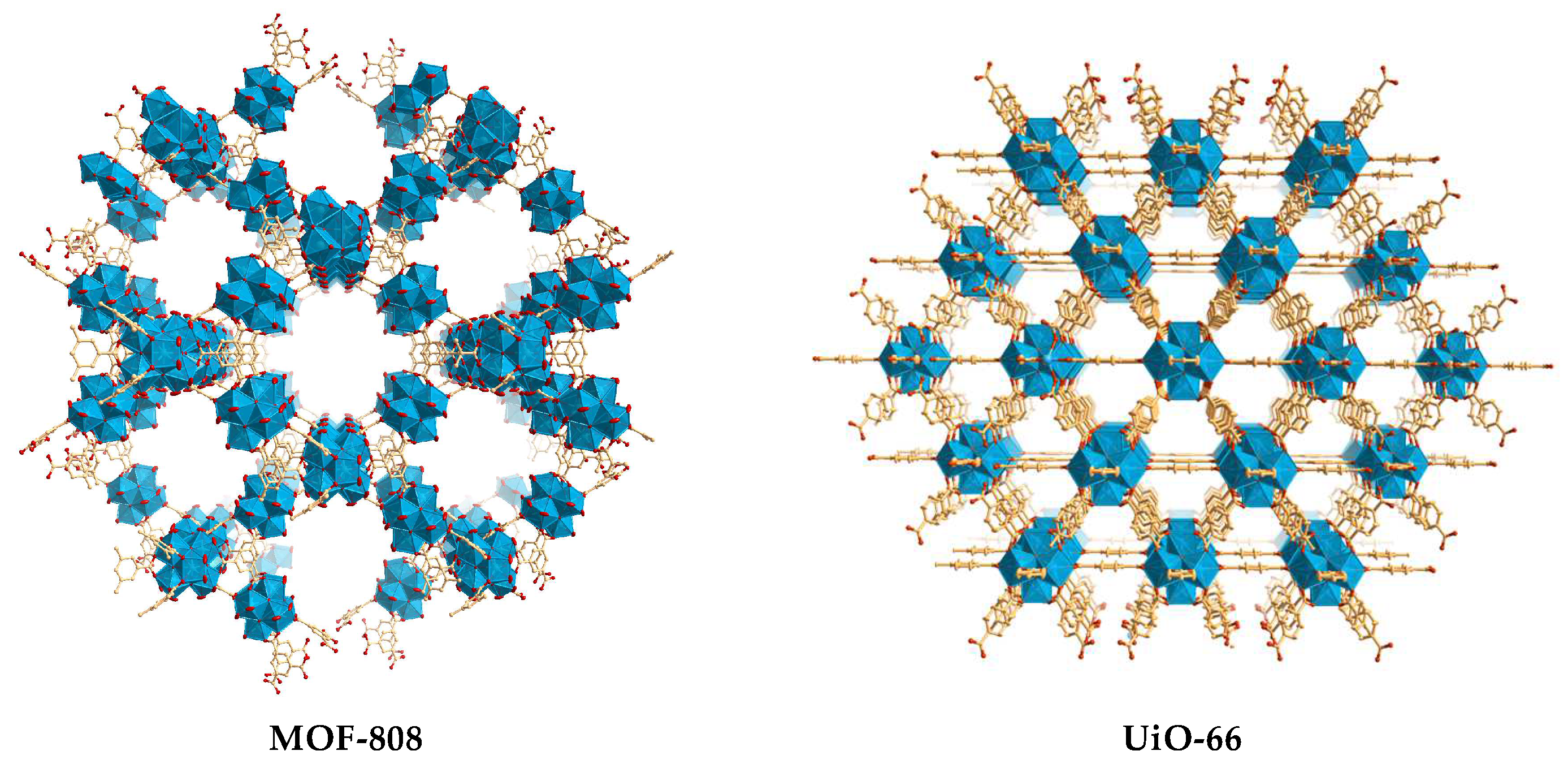
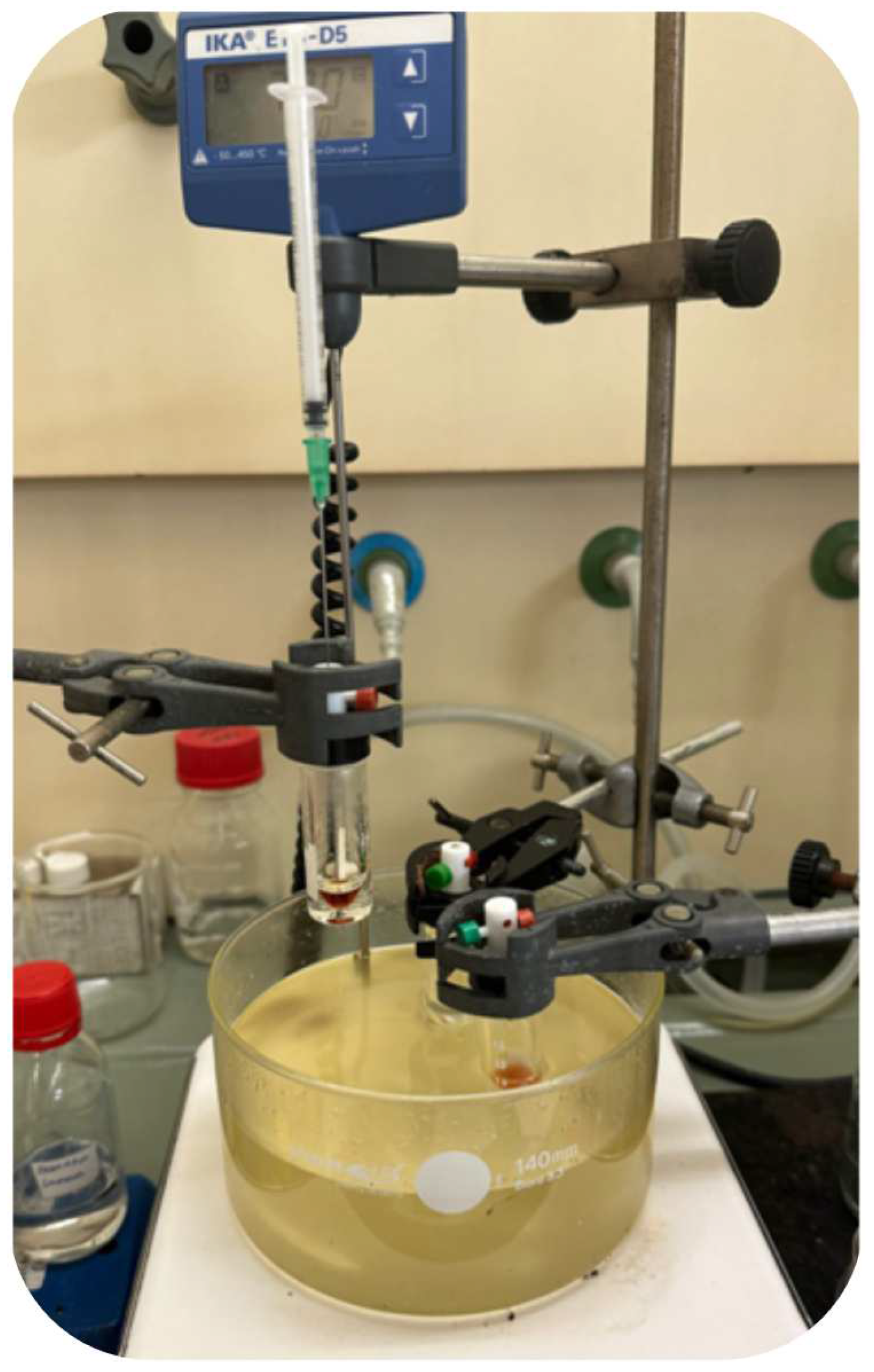
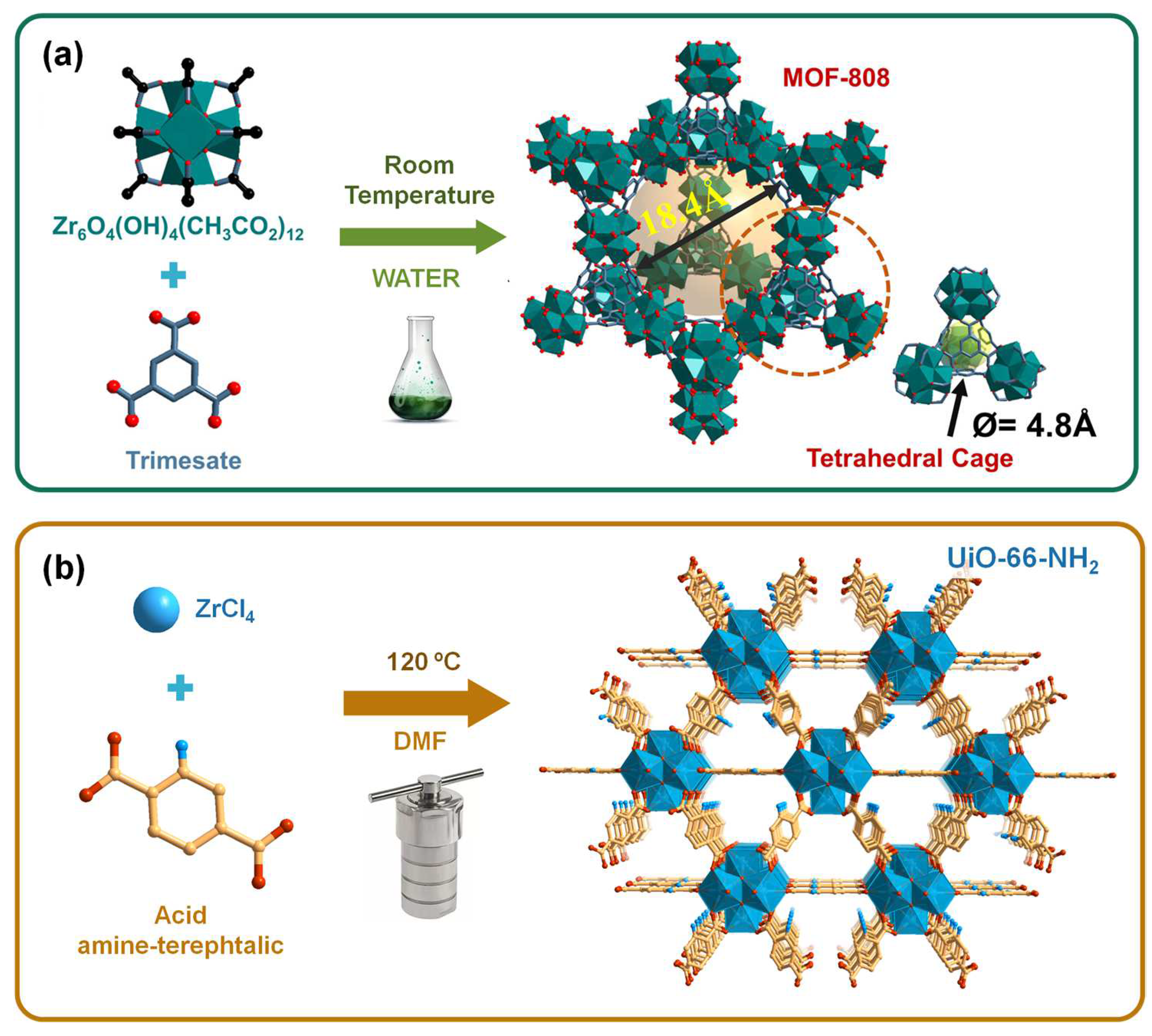



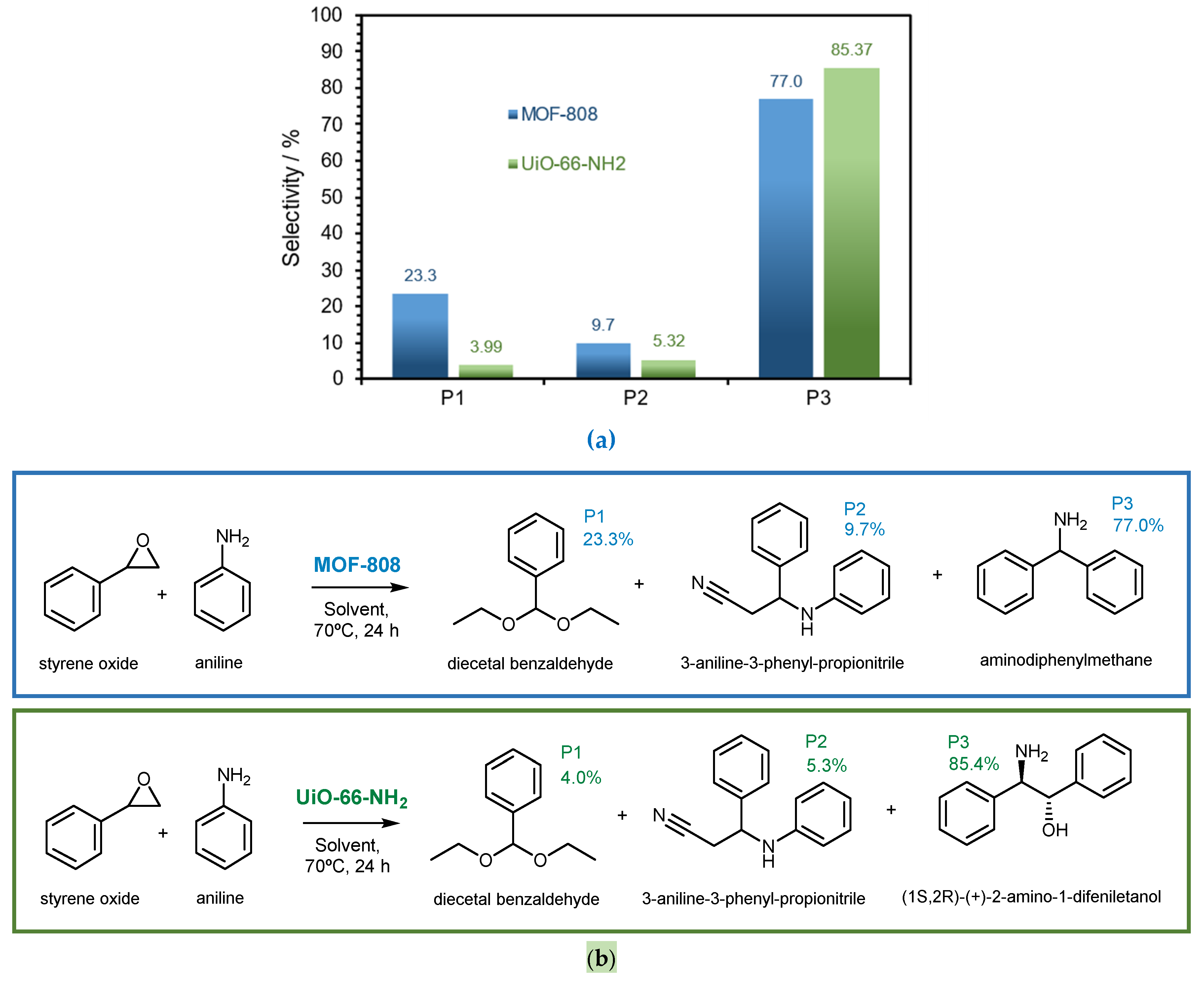


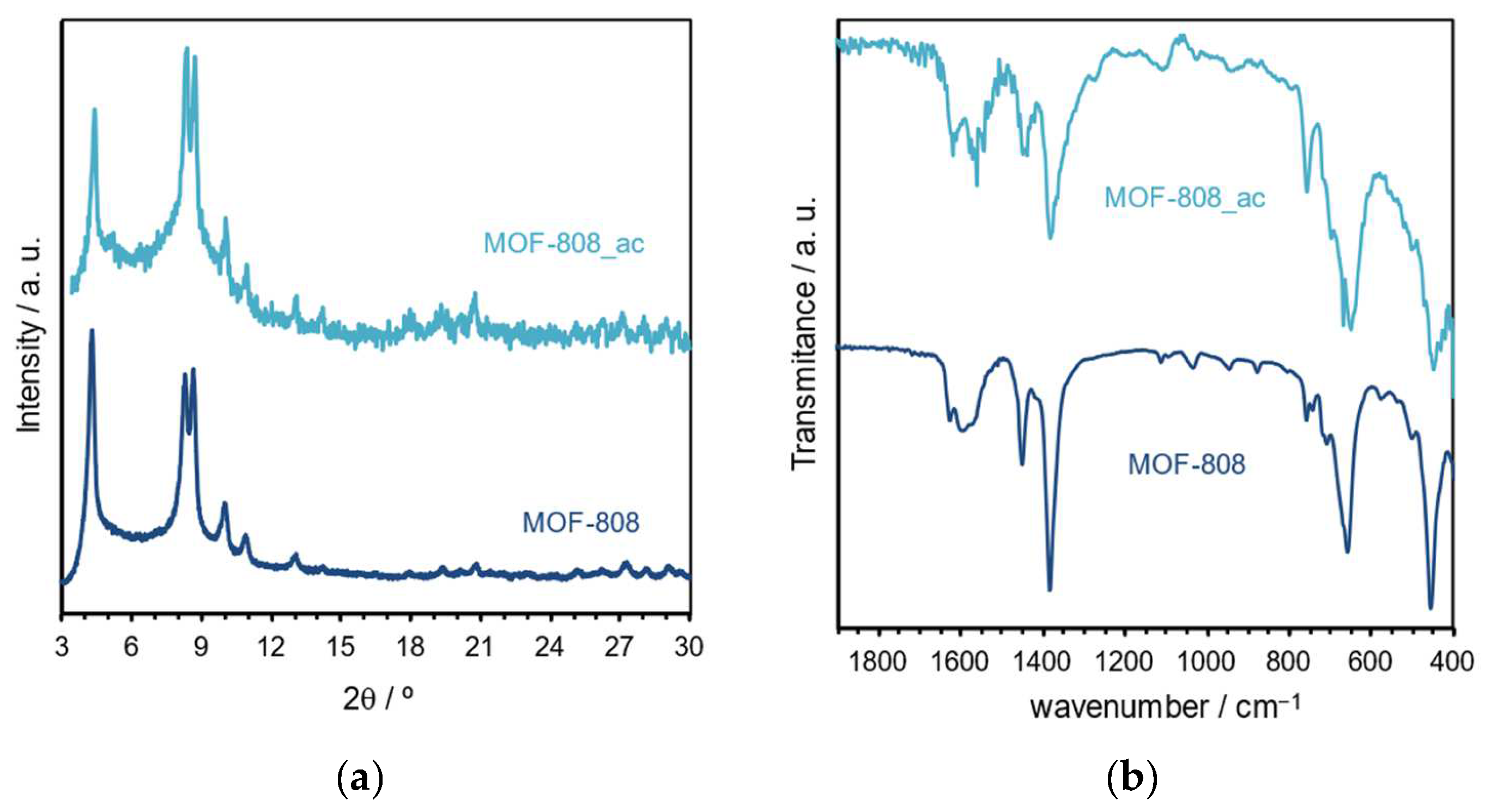
| Solvent | Conversion (%) | |
|---|---|---|
| Styrene oxide | 1.5 mL EtOH | 10% |
| 0.5 mL EtOH | 16% | |
| 1.5 mL MeCN | 14% | |
| Cyclohexane oxide | 1.5 mL EtOH | 10% |
| 0.5 mL EtOH | 11% | |
| 1.5 mL MeCN | 13% |
| Catalyst | Epoxide | Epoxide/Aniline (mmol) | Catalyst Amount | Solvent | T (°C) | Time (h) | Conv. (%) | Refs. |
|---|---|---|---|---|---|---|---|---|
| Cu-MOF | CyclohexOx | 1/21 | 0.11 mmol | no | rt | 4 | 32 | [47] |
| Fe-BTC | StyrOx | 41.6/41.6 | 150 mg | MeCN | 80 | 24 | 72 | [48] |
| [Co3+-Ln3+] a | CyclohexOx | 0.98/1.18 | 49 μmol | No | rt | 4 | 98 | [50] |
| [Co3+-Ln3+] a | StyrOx | 0.87/1 | 44 μmol | No | rt | 4 | 84 | [50] |
| MIL-101(Fe) | CyclohexOx | 1/0.9 | 55 μmol | MeCN | 80 | 24 | 87 | [28] |
| MIL-101(Fe)-NH2 | CyclohexOx | 1/0.9 | 55 μmol | MeCN | 80 | 24 | 86 | [28] |
| PW11Fe@MIL-101(Fe) | StyrOx | 1/0.9 | 50 μmol | MeCN | 80 | 1 | 97 | [36] |
| MIL-101(Cr) | StyrOx | 1/0.9 | 50 μmol | MeCN | 80 | 5 | 0 | [36] |
| Cu3(BTC)2 | StyrOx | 0.3/0.25 | 25 mg | No | 60 | 24 | 75 | [49] |
| Fe-BTC | StyrOx | 0.3/0.25 | 25 mg | no | 60 | 24 | 77 | [49] |
| MOF-808 | StyrOx | 1/0.9 | 1 μmol | EtOH | 70 | 6 | 83 | here |
| UiO-66-NH2 | StyrOx | 1/0.9 | 1 μmol | EtOH | 70 | 24 | 88 | here |
| MOF-808 | CyclohexOx | 1/0.9 | 1 μmol | EtOH | 70 | 24 | 88 | here |
Disclaimer/Publisher’s Note: The statements, opinions and data contained in all publications are solely those of the individual author(s) and contributor(s) and not of MDPI and/or the editor(s). MDPI and/or the editor(s) disclaim responsibility for any injury to people or property resulting from any ideas, methods, instructions or products referred to in the content. |
© 2024 by the authors. Licensee MDPI, Basel, Switzerland. This article is an open access article distributed under the terms and conditions of the Creative Commons Attribution (CC BY) license (https://creativecommons.org/licenses/by/4.0/).
Share and Cite
Ferreira, C.E.S.; Santos-Vieira, I.; Gomes, C.R.; Balula, S.S.; Cunha-Silva, L. Porous Coordination Polymer MOF-808 as an Effective Catalyst to Enhance Sustainable Chemical Processes. Polymers 2024, 16, 968. https://doi.org/10.3390/polym16070968
Ferreira CES, Santos-Vieira I, Gomes CR, Balula SS, Cunha-Silva L. Porous Coordination Polymer MOF-808 as an Effective Catalyst to Enhance Sustainable Chemical Processes. Polymers. 2024; 16(7):968. https://doi.org/10.3390/polym16070968
Chicago/Turabian StyleFerreira, Catarina E. S., Isabel Santos-Vieira, Carlos R. Gomes, Salete S. Balula, and Luís Cunha-Silva. 2024. "Porous Coordination Polymer MOF-808 as an Effective Catalyst to Enhance Sustainable Chemical Processes" Polymers 16, no. 7: 968. https://doi.org/10.3390/polym16070968
APA StyleFerreira, C. E. S., Santos-Vieira, I., Gomes, C. R., Balula, S. S., & Cunha-Silva, L. (2024). Porous Coordination Polymer MOF-808 as an Effective Catalyst to Enhance Sustainable Chemical Processes. Polymers, 16(7), 968. https://doi.org/10.3390/polym16070968









